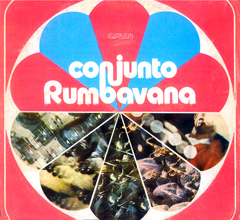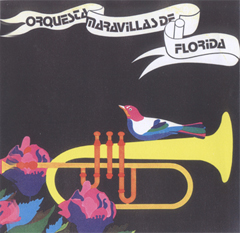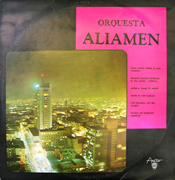Indice - Table of contents
Lo Nuevo[hide]
Reportes: From The St... : Cubadisco 2...
Tienda: Cuban Music Store
Reportes: From The St... : Cubadisco 2...
Fotos: Tom Ehrlich
Staff: Kristina Lim
Musicos: Juan Formell
Musicos: Yordamis Megret Planes
Musicos: Yasser Morejón Pino
Musicos: José Luis "Changuito" Quintana...
Musicos: Dennis Nicles Cobas
Fotos: Eli Silva
Grupos: Ritmo Oriental : 1988 - Vol. IX - 30 a...
Musicos: Rafael Paseiro Monzón
Musicos: Jiovanni Cofiño Sánchez
Fotos Del Día [hide]
The Roots of Timba, Pt. III - 1980
 Rumbavana -- Revé and Rumbavana both started in 1956 - Revé as a typical charanga with flute, strings and timbal, and Rumbavana as a conjunto with bongó and trumpets, but without the traditional tres.
Rumbavana -- Revé and Rumbavana both started in 1956 - Revé as a typical charanga with flute, strings and timbal, and Rumbavana as a conjunto with bongó and trumpets, but without the traditional tres.
Unlike Adalberto and Revé, Rumbavana never experimented with their instrumentation, but their style went through several evolutionary stages. Like Aragón, they couldn't help but be affected by the "perfect storm" of the early 70s and their style became more and more aggressive and creative, especially leader Joseíto González' piano playing and arranging, and the bass-playing of Silvio Vergara, about whom we'll be hearing a lot more when we get to 1982.
Rumbavana played plenty of boleros, chachachás and traditional sones, but they called their modern "pre-timba" dance tracks "bachata-son" and "bachata-guaguancó". We're looking for the specific musical reasoning behind borrowing the name of the Dominican genre, so if you have any theories, please write in . Here are some highlights of the two styles from 1980's Conjunto Rumbavana:
• Baila este son (bachata-son) [source] - Note the 10ths in the piano tumbao after the first bloque and the magnificent bass-playing after the second.
• El son de campeón (bachata-son) [write EGREM] - In timba, the breakdown gears are based on removing the bass tumbao. Here, as with Ritmo Oriental, the breakdown removes everything except the bass. Again, listen carefully to Vergara's tasteful but virtuosic bass-playing towards the end of the clip.
• Negro de sociedad (chachacha - bachata-guaguancó) [write EGREM] - This is an amazing and hilarious arrangement of the old 50s standard. The original (at least as my Spanish-challenged brain perceives it) was about a successful and sophisticated black man who tells his girlfriend not to dance the supposedly vulgar and low-class dances of the black culture he's trying to discard from his new life (or something like that). The irony, as Joseíto González' brilliant arrangement illustrates, is that these "vulgar low class" rhythms turned out to be among the most glorious, sophisticated and timeless of mankind's creations. Listen to the dated-sounding chachachá as it morphs into a 12/8 folkloric groove in the first example, and a torrid bachata-guaguancó in the second. It's pretty clear which of the argumentative dance partners turned out to be the sophisticated one.
 Maravillas de Florida -- Los Maravillas had been playing traditional charanga since the 50s but, inspired by La Ritmo and Aragón's cha-onda, they began to modernize in 1980 with the self-titled Areíto LD-3856. The same tracks are available on CD on the Salsa Center label if you can find it. Fernando Cabrera and the brilliant percussionist/composer Eladio Terry were the key figures until a young pianist named Manolito Simonet came along.
Maravillas de Florida -- Los Maravillas had been playing traditional charanga since the 50s but, inspired by La Ritmo and Aragón's cha-onda, they began to modernize in 1980 with the self-titled Areíto LD-3856. The same tracks are available on CD on the Salsa Center label if you can find it. Fernando Cabrera and the brilliant percussionist/composer Eladio Terry were the key figures until a young pianist named Manolito Simonet came along.
Most of the pre-1980 Maravilla is traditional charanga, but there's one really exciting track, Y pa' qué [source] that appears to be a single released in 1975. Listen to the way Eladio Terry's astouding chékere-playing implies 12/8 against the 4/4 groove.
Moving on to the 1980 album, it's interesting to note that the style of Los Maravillas was very similar to Aragón's - even going so far as to use the term "cha-onda" in one of the coros from Me gustas y lo sabes [write EGREM]. Compare this, or the next track, Baila güiro, son wambarí to the Aragón examples from our 1977 section (ex. 1 - ex. 2). The key to the sparse, exotic sound is the fact that piano is doubling the bass instead of playing tumbao. When this happens in timba, it's often called "motivo", but on these albums, with the guajeo played by the violins, it takes the place of the main marcha gear. Without a piano tumbao and with the strings playing more legato than a typical charanga guajeo, the percussion stands out much more and the overall track has a sparse, funky feeling. In Volume III, we'll have much more on motivo, combinations of guajeos, and the textures of rhythm sections in general.
 Orquesta Aliamén -- The modern charanga craze was in full swing as Aliamén became the next traditional group to catch the fever. Their first album in the new style was closer to Ritmo Oriental than Maravilla and Aragón. Instead of the sparser cha-onda approach, they had a full-bodied groove as can be heard on the opening track Oiga como suena el son [source] with piano tumbao, string guajeos, and even a guitar. Only two of the 5 tracks are in the up-tempo modern style, but this one, and Traigo un tumbaíto sabroso, make it well worth tracking down the CD. The singer on both tracks is the young Sixto "El Indio" Llorente who later sang many of Manolito's biggest hits.
Orquesta Aliamén -- The modern charanga craze was in full swing as Aliamén became the next traditional group to catch the fever. Their first album in the new style was closer to Ritmo Oriental than Maravilla and Aragón. Instead of the sparser cha-onda approach, they had a full-bodied groove as can be heard on the opening track Oiga como suena el son [source] with piano tumbao, string guajeos, and even a guitar. Only two of the 5 tracks are in the up-tempo modern style, but this one, and Traigo un tumbaíto sabroso, make it well worth tracking down the CD. The singer on both tracks is the young Sixto "El Indio" Llorente who later sang many of Manolito's biggest hits.
Opus 13 -- 1980 was also the year that master arranger Joaquín Betancourt founded Opus 13 with an album called Para una mulata tropical. We have the year, but no photo, no EGREM number, and -- most tragically -- no music. Please write in if you have any information about this rare vinyl-only release. Opus 13 had a complex instrumentation with strings, guitar, brass and winds to showcase the work of Betancourt and Juan Ceruto.

















